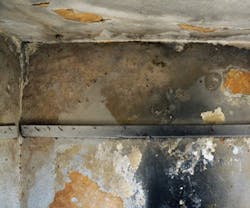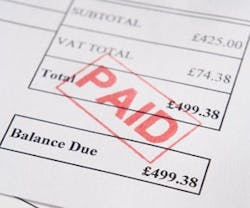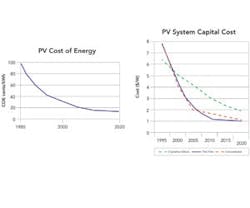Newsworthy
BUILDINGS: Are green buildings at risk of mold more than traditional ones?
Shipp: Green buildings tend to be sealed at higher levels against air leakage. The benefit of a tight building envelope – less air leakage and energy heat flow – can also create conditions for high humidity and mold growth. Reduced air flow means moisture can get trapped and become a host to mold.
However, all the sensitive areas that apply to regular buildings apply to green buildings. Classic problem areas include the roof, walls, and windows, which can contain design or maintenance issues. Inadequate flashing around pipes, fixtures, or ducts can also interfere with proper water management.
Two frequently overlooked areas are the gutters and landscaping. If gutters simply dump water at the foundation, it puts extreme stress on the foundation itself from being able to manage water properly. The grade of your landscape must also ensure water flows away from the building, instead of towards it and eventually to a crack.
BUILDINGS: Can green construction lend itself to water intrusions?
Shipp: No building is absolutely watertight. Issues arise when water comes in contact with an element that is moisture-sensitive. When you change one thing in the composition of a building or material, there are always effects that will propagate in its performance. You don't want to run afoul of moisture management fundamentals by expecting the composition of new materials to behave like traditional ones.
For example, exterior insulation and finish systems (EIFS) can be made to look like stone or stucco cladding. Yet EIFS is mostly polystyrene plastic, which has very different thermal and moisture characteristics. It has a low moisture permeance value and virtually no water storage capacity, which is dramatically different than stone. Even though they look the same, in a rainstorm, they're going to behave very differently.
BUILDINGS: Can recyclable materials encourage mold?
Shipp: Though recyclable materials alone don't contribute to mold growth, there's a distinct possibility that properties of the recycled content have altered the material's performance. You need to evaluate the recycled item's moisture permeability. Does it trap moisture or is it resistant to it? Is it suitable for the moisture level of its environment?
Biodegradable materials, on the other hand, are predisposed by nature to mold. You don't want to use them in an applications where you can't get to them or replace them easily.
BUILDINGS: How do you balance green materials with durability?
Shipp: You have to weigh your choices as to what is the greenest construction material to use. You don't want to use items that will ultimately be degraded by water and mold – it doesn't serve the general philosophy of sustainability to use materials and not protect them appropriately. For example, the worth of your hundred-year ceramic tile will be compromised if you install it on top of a substrate that's going to disappear or have problems after ten years.
Selecting durable materials with good longevity and appropriate moisture properties are part of the equation for producing a sustainable structure. Don't let poor material selection or design turn your green building into a showcase of preventative repairs and high maintenance.
Use RFIDs to Unwire Your HVACs
Wireless monitoring technology can be implemented by tapping into a building's HVAC ducts, according to recent research. This can lead to both time and cost savings for builders and building managers, because the systems can be put into place without running wires throughout the building – saving money and effort.
Radio-frequency identification (RFID) systems use centralized readers to collect data from small, lightweight tags that are equipped with radio antennas. The reader broadcasts a radio wave with a specific frequency. When the RFID tag receives the transmission, it absorbs energy from that transmission, which enables it to respond to the reader by the way it reflects the wave.
"This would work with anything you can create an electronic sensor for," explains Dan Stancil, co-author of the study paper and professor and head of North Carolina State's Department of Electrical and Computer Engineering.
The study focused on ultrahigh-frequency (UHF) RFID systems. UHF RFID tags typically need to be within 5-10 meters of the reader in order to respond to a transmission, when placed in open spaces. However, by tapping into a building's HVAC system, UHF RFID tags can operate when located 30 meters or more from a reader, according to the researchers.
The ductwork is a good conduit for the radio transmissions because the ducts typically consist of hollow metal pipes – which can be used to guide the radio waves, keeping the radio waves from dispersing and maintaining a strong signal over a distance, even up to 30 meters long.
Instead of using thermometers connected to a central climate-control monitor by extensive wiring, send temperature data to readers through the ductwork by using distributed RFID tags with temperature sensors, which would have short antennas connecting them to the building's HVAC ductwork.
"Because you can tap into existing infrastructure, I think this technology is immediately economically viable," says Stancil. "Avoiding the labor involved with installing traditional sensors and the related wiring would likely more than compensate for the cost of the RFID tags and readers."
Don't Pay Right Away
Slip-and-fall claims that target businesses (and their insurance companies) are being scrutinized more carefully for potential fraud, according to the National Insurance Crime Bureau (NICB).
"While many people have legitimate accidents in stores and businesses across the country, we've seen a growing number of cases that have some indication of potential fraud," says Jo Wehrle, NICB president and chief executive officer. "Our agents, working with insurance company investigators and law enforcement, are busy identifying and targeting organized criminal rings that make a good living staging slip-and-fall accidents."
There has been a 57% increase in the number of referrals over the past 2.5 years, according to an analysis of questionable slip-and-fall claims submitted by NICB members. The number of questionable claims submitted to NICB went from 325 in the first quarter of 2008 to 565 in the fourth quarter of 2009.
"Fortunately, we've worked with insurers to raise the awareness level and urged companies to analyze claims before they pay," Wehrle says. "The bad news is, many retailers are self-insured and they look at this as a cost of doing business – they'll write a check without investigating. Based on what companies have told us, we think that adds up to millions of dollars in unwarranted payouts. We're reaching out to these companies and urging them to join us in fighting commercial fraud."
For more information and the full report, visit www.nicb.org.
From Bed to Office: Bed Bug Resurgence
Bed bugs are not only making a comeback in hospitality and residential environments, but also increasing their presence in commercial real estate properties.
With the alarming presence of bed bugs in the hospitality and residential industries, the potential for business travelers and apartment-dwelling employees to pick up bed bugs and bring them into the office has greatly increased, creating a bed bug boom in commercial real estate.
Orkin conducted a survey with BOMA earlier this year and found that one in 10 respondents reported bed bug incidents in a commercial property. "10% may not sound significant at first, but it is a concerning statistic when you consider that these properties don't represent the typical bed bug habitat – a place where people sleep," explains Ron Harrison, Orkin's director of technical services.
Increased international travel and a more targeted approach to pest control may be contributing to the reestablished presence of bed bugs in the U.S.
For more information on bed bugs, read "Sustainability Efforts to Curb Bed Bugs."
New Door Hardware Standards
New standards for self-closing hinges, pivots, and architectural door hardware are now available from the Builders Hardware Manufacturers Association (BHMA).
- ANSI/BHMA A156.17 – The 2010 American National Standard for Self Closing Hinges & Pivots includes revisions to strengthen safety. Because self-closing hinges and pivots affect a door's overall function, tests and results identified in the standard include: static load, closing force, cycle, finish, and latch tests for single acting doors.
- ANSI/BHMA A156.6 – The 2010 American National Standard for Architectural Door Trim outlines strength and finish tests, including dimensional and material criteria for architectural door hardware. The standard applies to door protection plates, door edgings, push plates, door pulls, push bars, and pull bars.
For more information, visit www.buildershardware.com
PV Efficiency Increasing, Prices Decreasing
The cost of PV system electricity has dropped, with grid-connected PV systems currently selling for approximately 20-50 cents per kWh. With efficiency of PV systems steadily increasing and projected to continue, both the capital cost and the cost of energy from PV systems have an inverse relationship with efficiency, declining as it increases.




